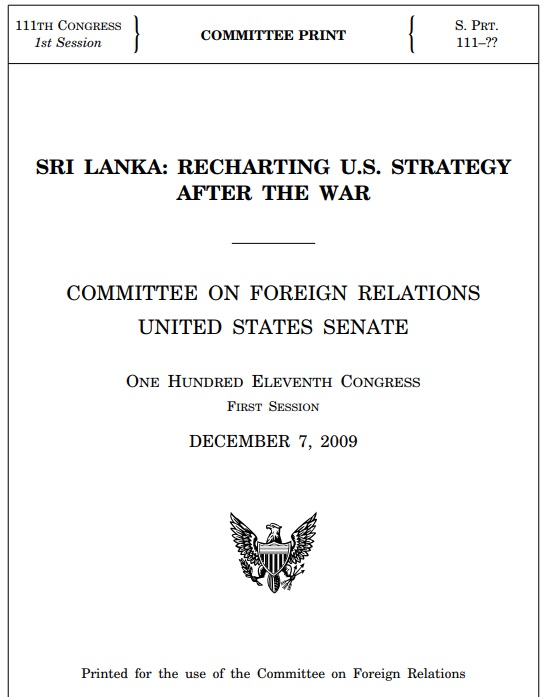-By A Special Correspondent

(Lanka-e-News -02.Sep.2025, 11.15 PM) When the dust of Sri Lanka’s civil war finally settled in May 2009, the headlines around the world focused largely on human rights, humanitarian access, and the fate of the Tamil population. But in Washington, a different conversation was quietly unfolding inside the corridors of power. The U.S. House Foreign Affairs Committee circulated a document titled “Rechartering U.S. Strategy After the War” — a policy paper that, while framed in the language of peace and reconstruction, revealed a deeper preoccupation: Sri Lanka’s location.
For policymakers in Washington, Sri Lanka was not merely a post-war nation grappling with reconciliation. It was, and remains, a maritime jewel set in the Indian Ocean — the world’s busiest trade artery, through which energy supplies to China, Japan, and India flow uninterrupted. The Select Committee’s report placed unusual emphasis on geography, noting that Sri Lanka’s proximity to the Malacca Strait, its deep-water ports, and its central position between the Gulf and Southeast Asia rendered it a natural staging post for American military outreach.
The 2009 document was couched in diplomatic tones, but the undertone was unmistakable: Sri Lanka was to be viewed not only as a country recovering from a brutal civil conflict, but as a “strategic crossroads.” For the U.S., which had already recalibrated its Asia policy towards what later became known as the “Pivot to Asia,” the island was flagged as indispensable in any future confrontation or competition with a rising China.
Indeed, in language that might have seemed dry to diplomats but will ring alarm bells for any seasoned military officer today, the report underscored that “Sri Lanka’s location provides a natural hub for forward presence, logistical operations, and maritime security in the Indo-Pacific.” In plain terms: a launchpad for influence, and if necessary, intervention.
For a senior colonel tasked with studying this document today, the relevance is striking. The report reads less like a post-war assessment and more like an early blueprint for the Indo-Pacific strategy that Washington would fully articulate a decade later. The emphasis on “stability” in Sri Lanka was as much about ensuring that the island did not drift into Beijing’s orbit as it was about reconciliation with the Tamil community.
American strategists were blunt in their internal debates. If Sri Lanka could be secured as a reliable partner, it would give Washington flexibility in any military adventure or contingency plan in Southeast Asia or beyond. If left to Chinese influence, it could become a liability, narrowing U.S. naval maneuverability in the Indian Ocean.
Although the report was published in 2009, it almost anticipated Sri Lanka’s later entanglement with Beijing — the Hambantota Port deal, the Colombo Port City project, and the increasing visibility of Chinese naval vessels in the region. What U.S. lawmakers feared then has since become a geopolitical reality: China’s growing presence on the island, often described as a “string of pearls” strategy to encircle India and expand its maritime reach.
For the U.S., this reinforced the original conclusion of the Select Committee: Sri Lanka was not a marginal concern. It was a test case of whether American diplomacy and influence could outpace China’s checkbook diplomacy.
In retrospect, Rechartering U.S. Strategy After the War was less about Sri Lanka’s internal politics and more about its external position. To any senior colonel or policymaker today, the document is not a relic but a prescient guide. It explains why Sri Lanka remains a contested space between great powers, why Washington keeps a close eye on Colombo’s decisions, and why the island will continue to attract the interest of foreign militaries.
The Select Committee saw Sri Lanka as a “vital location.” Two decades later, that assessment has only hardened into strategic orthodoxy. For the U.S., the war in Sri Lanka may have ended in 2009 — but the contest for the island’s allegiance was only just beginning.
-By A Special Correspondent
---------------------------
by (2025-09-02 18:47:54)
Leave a Reply